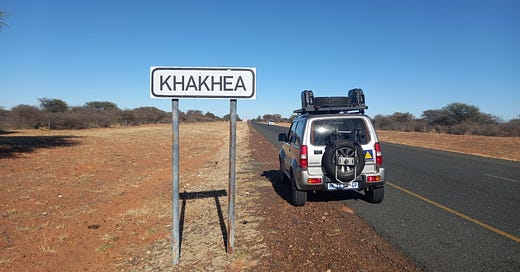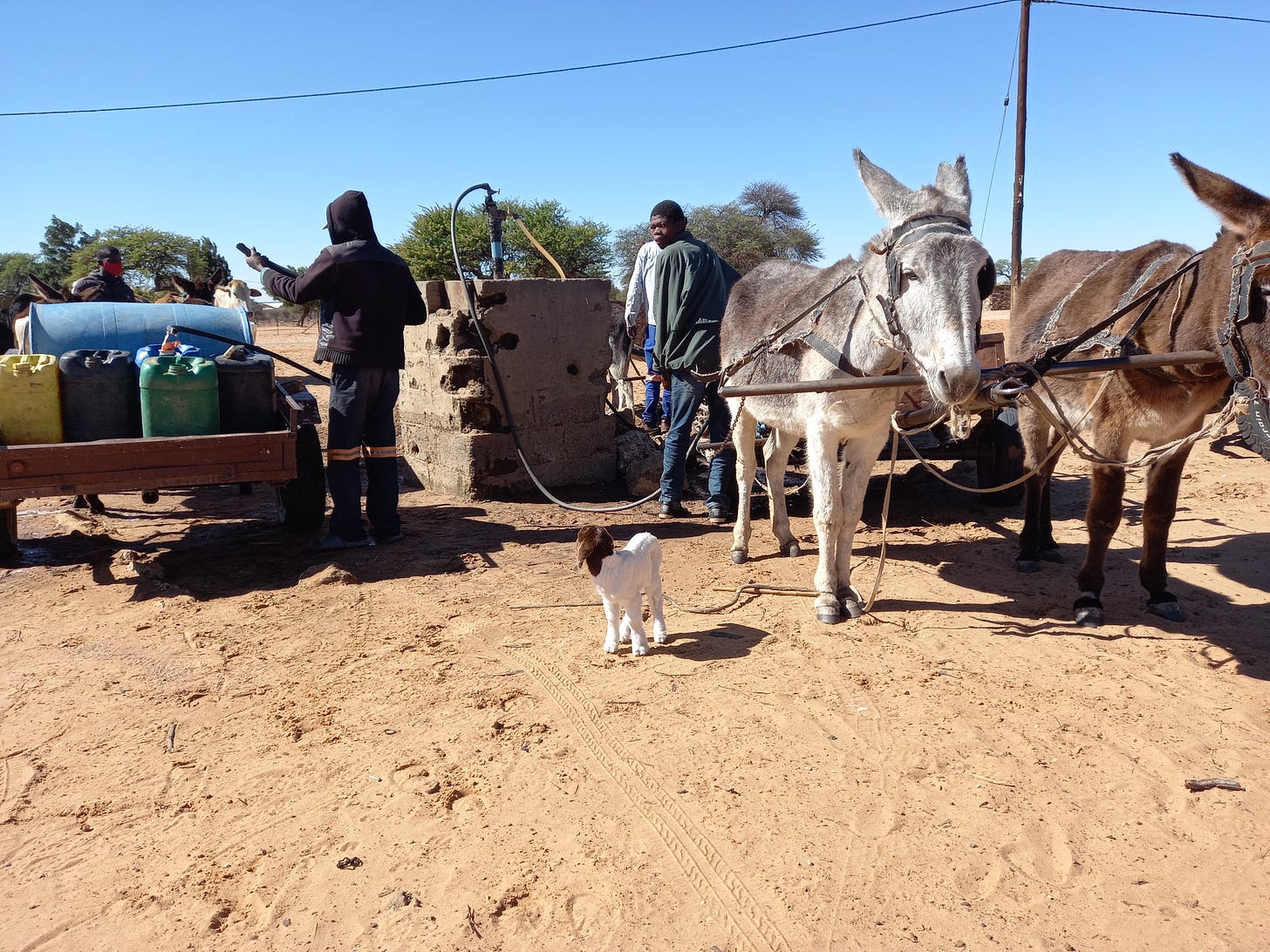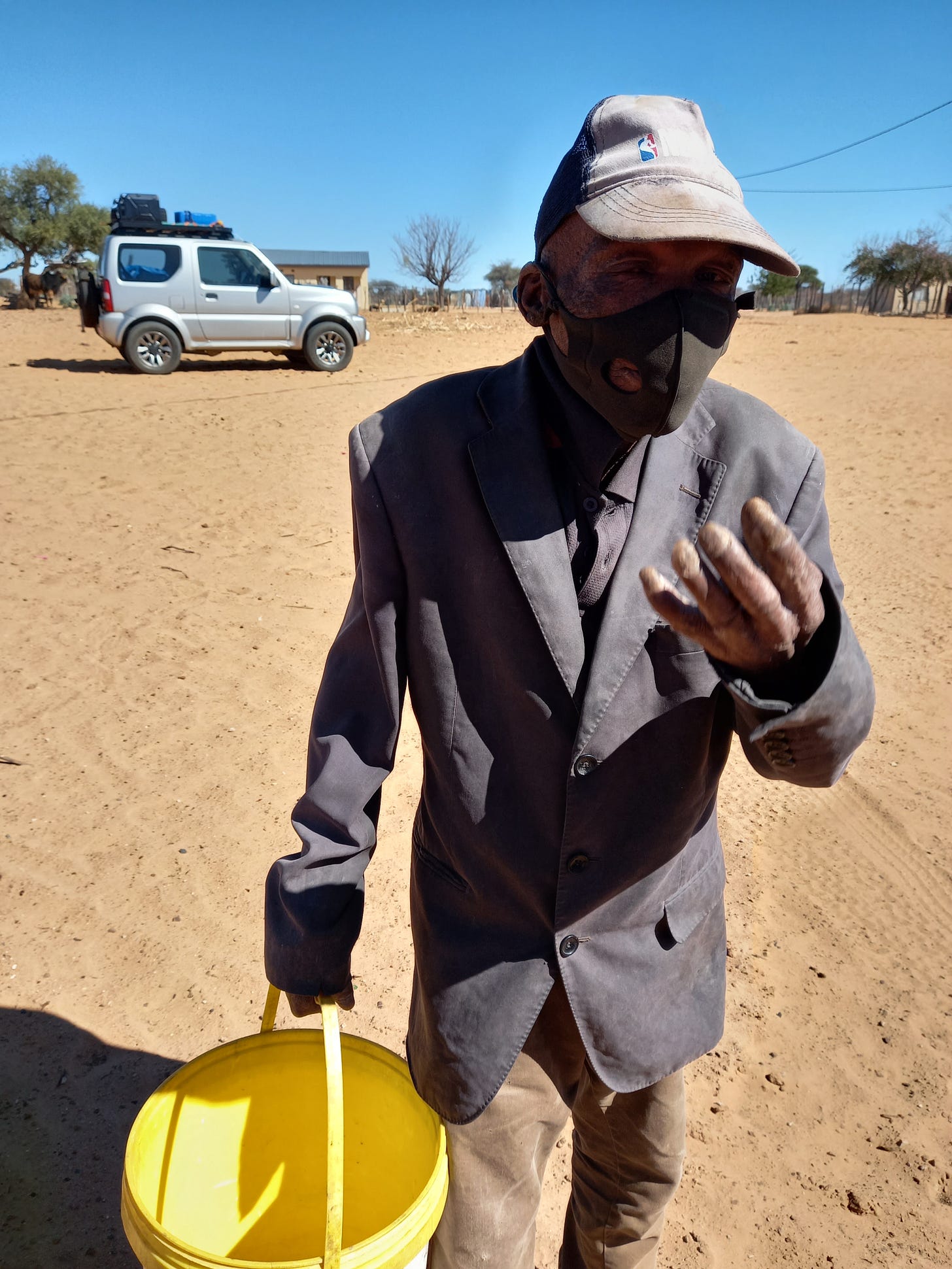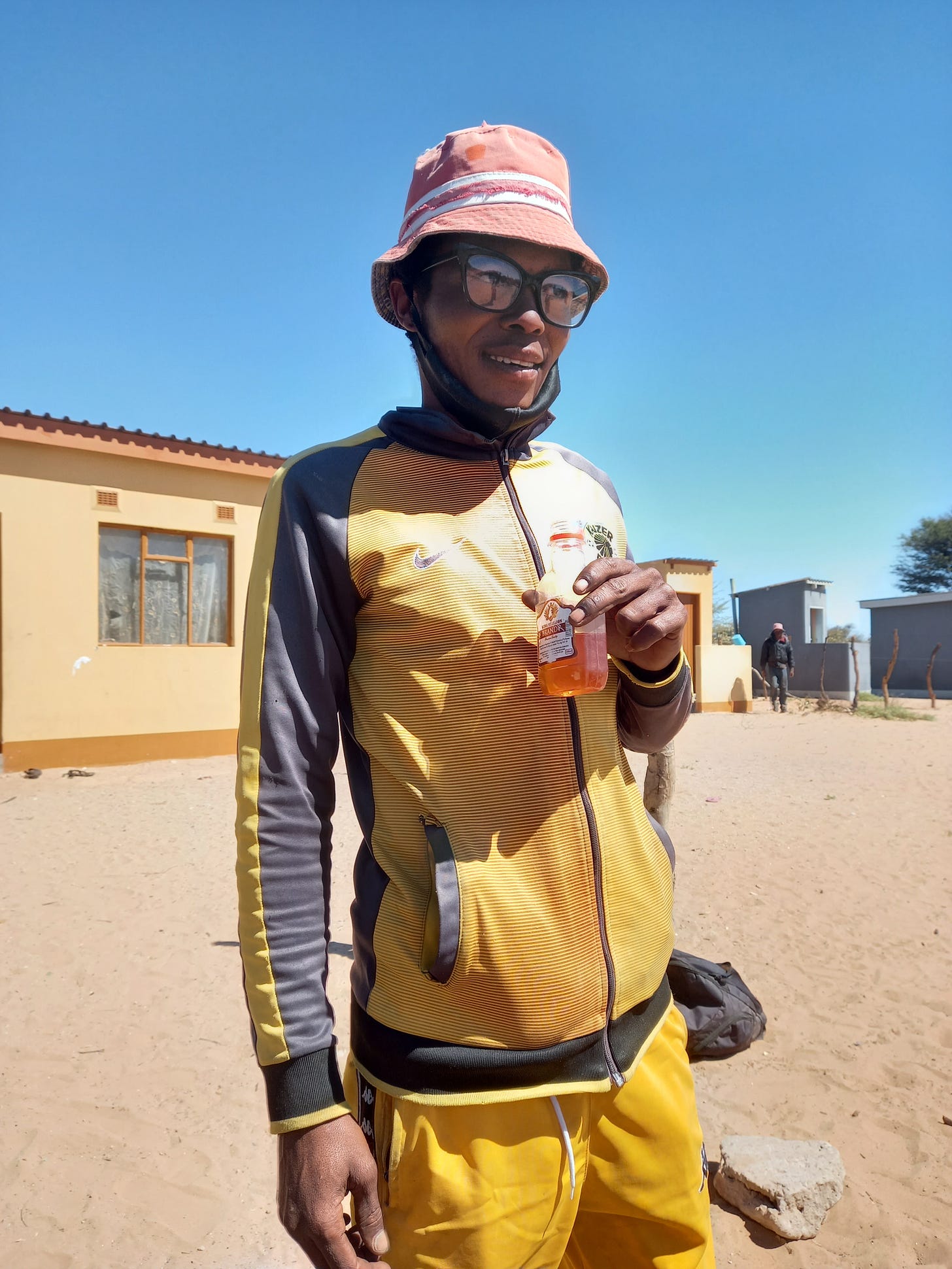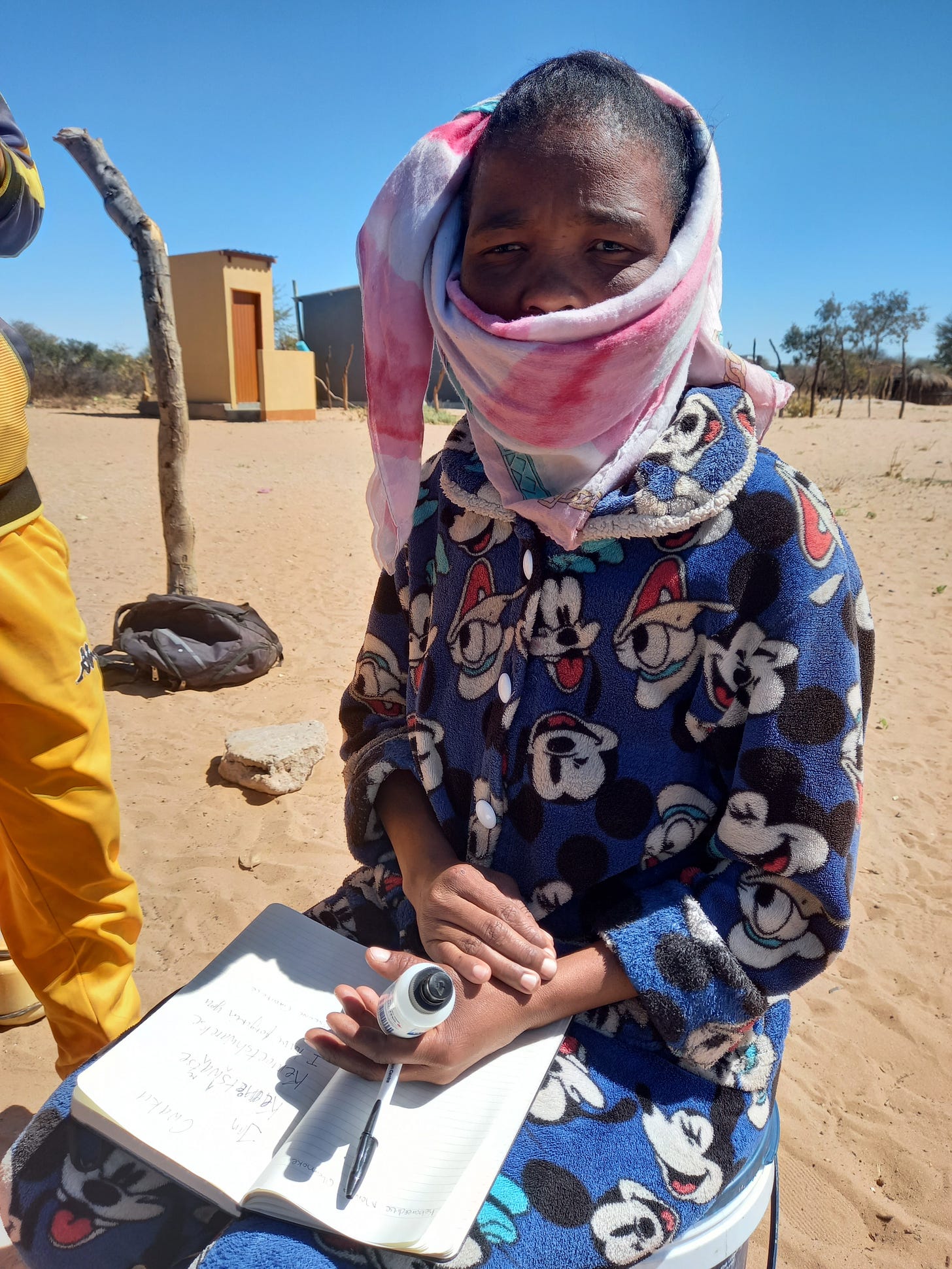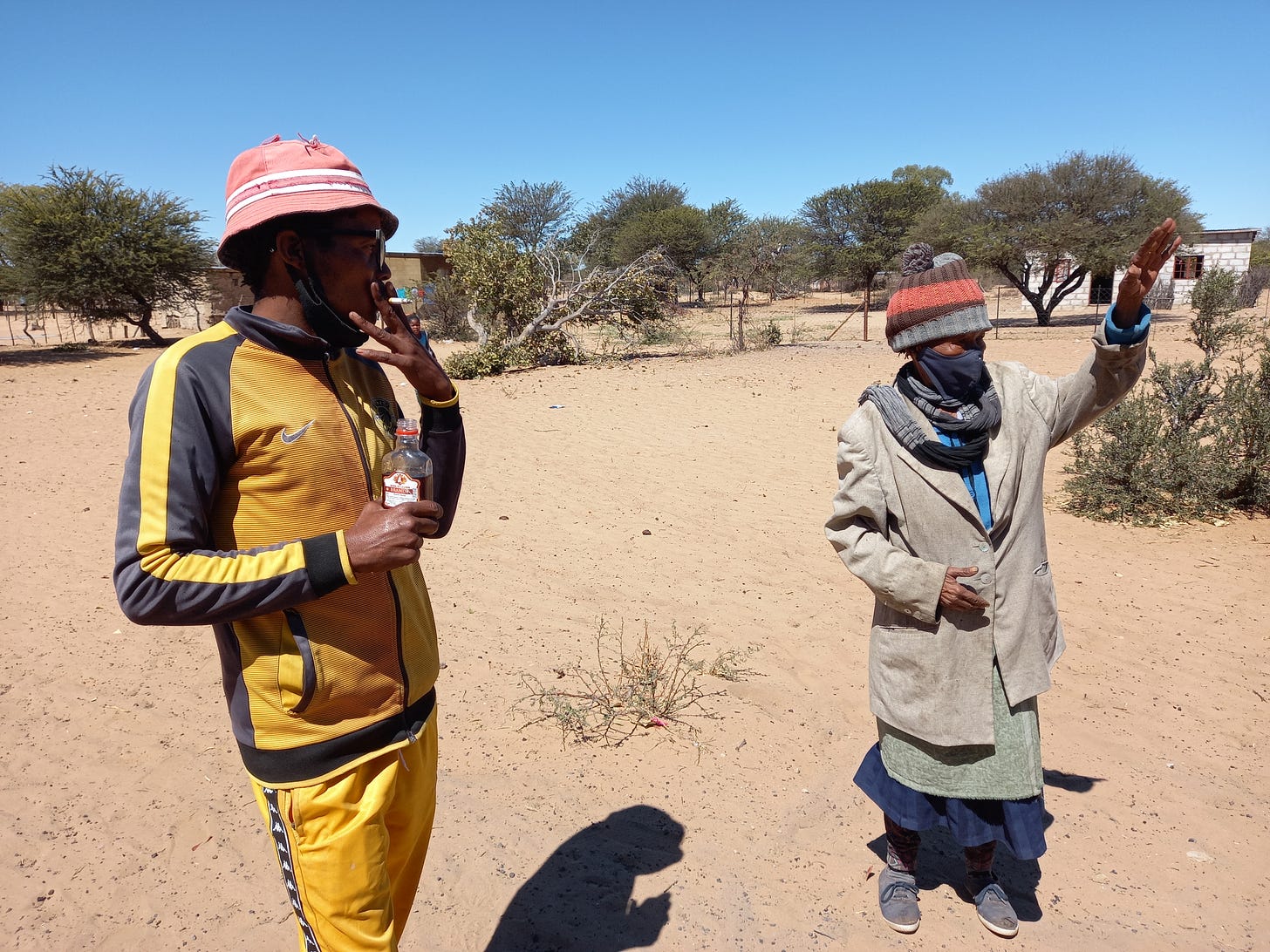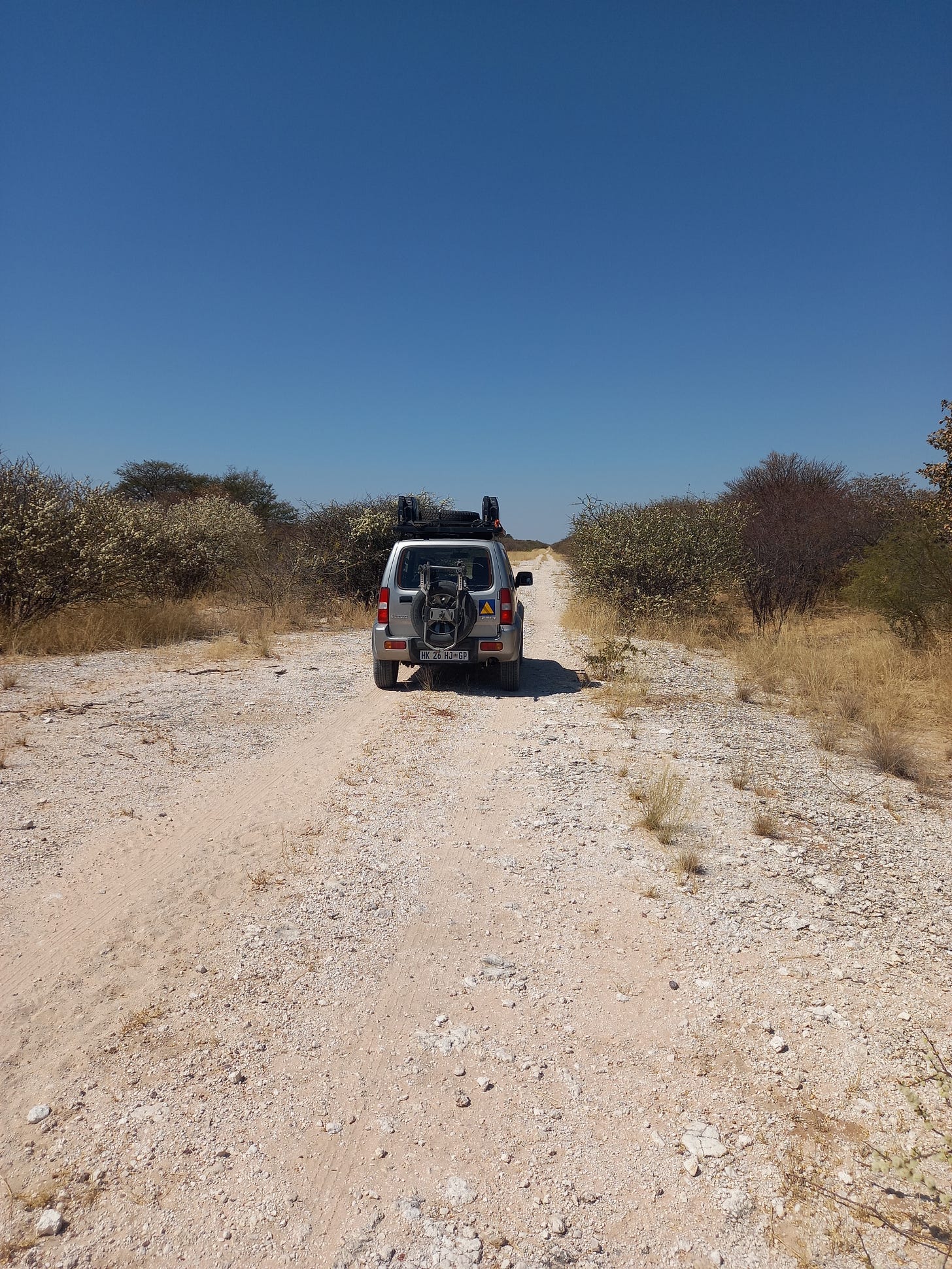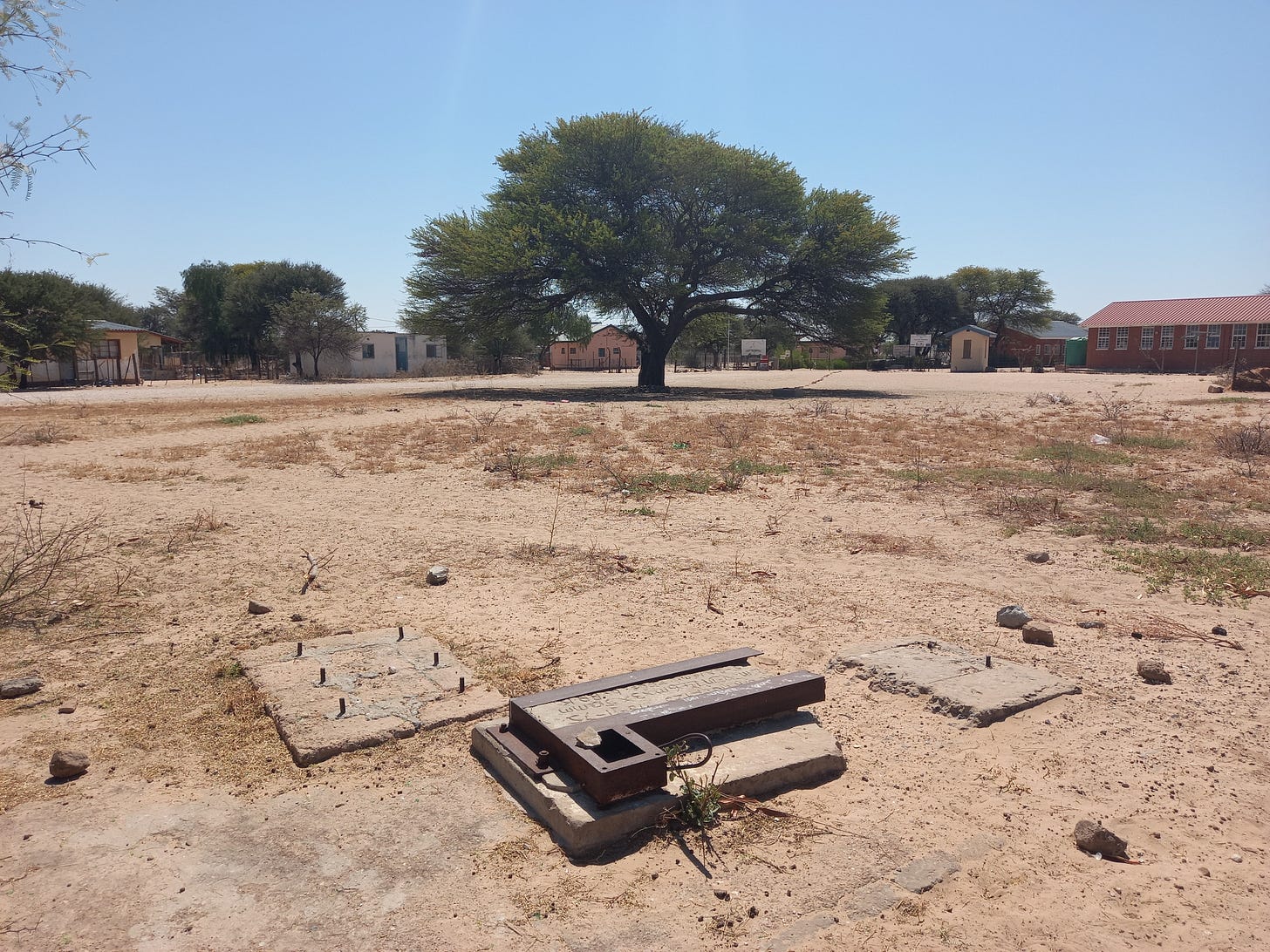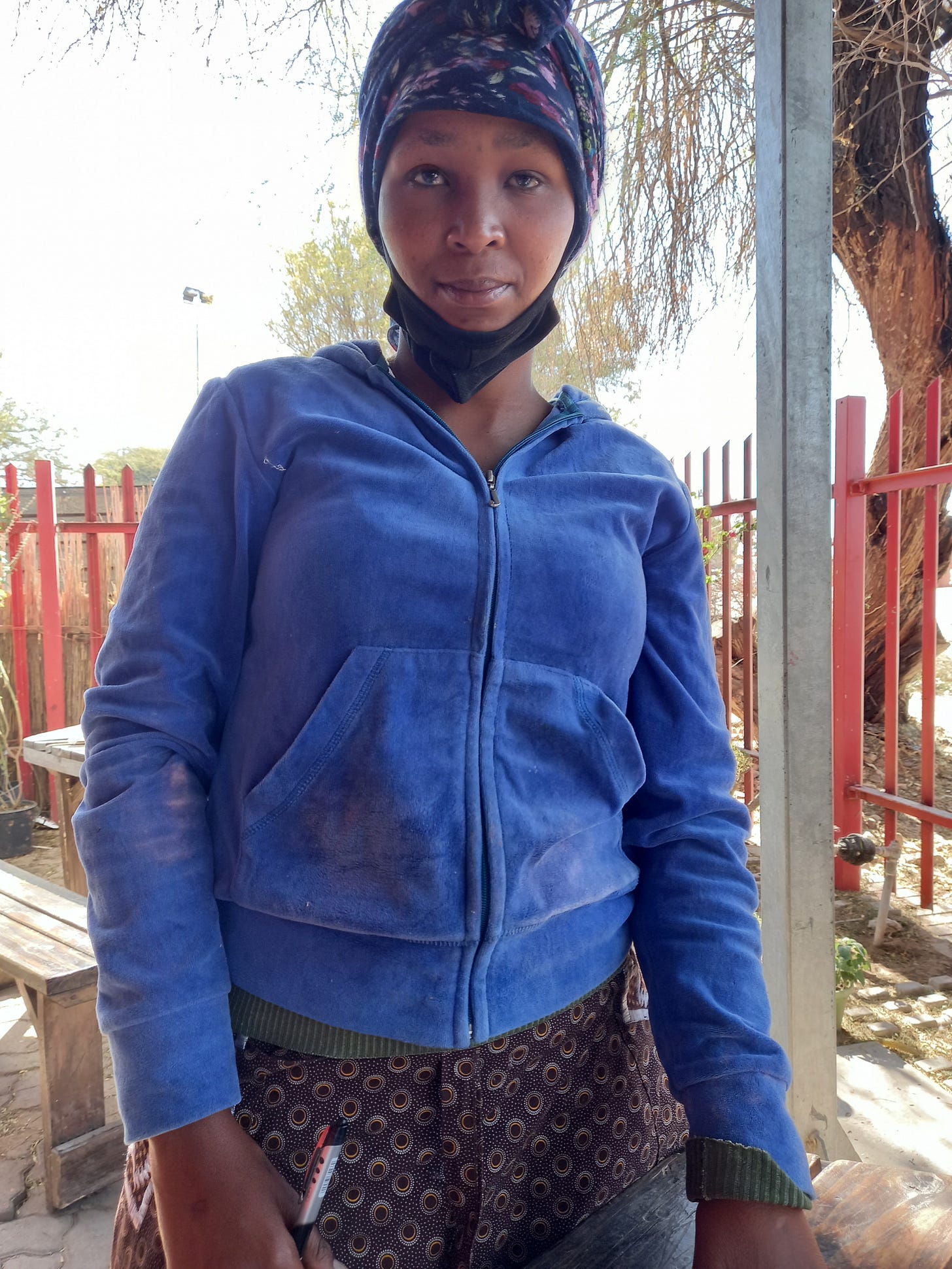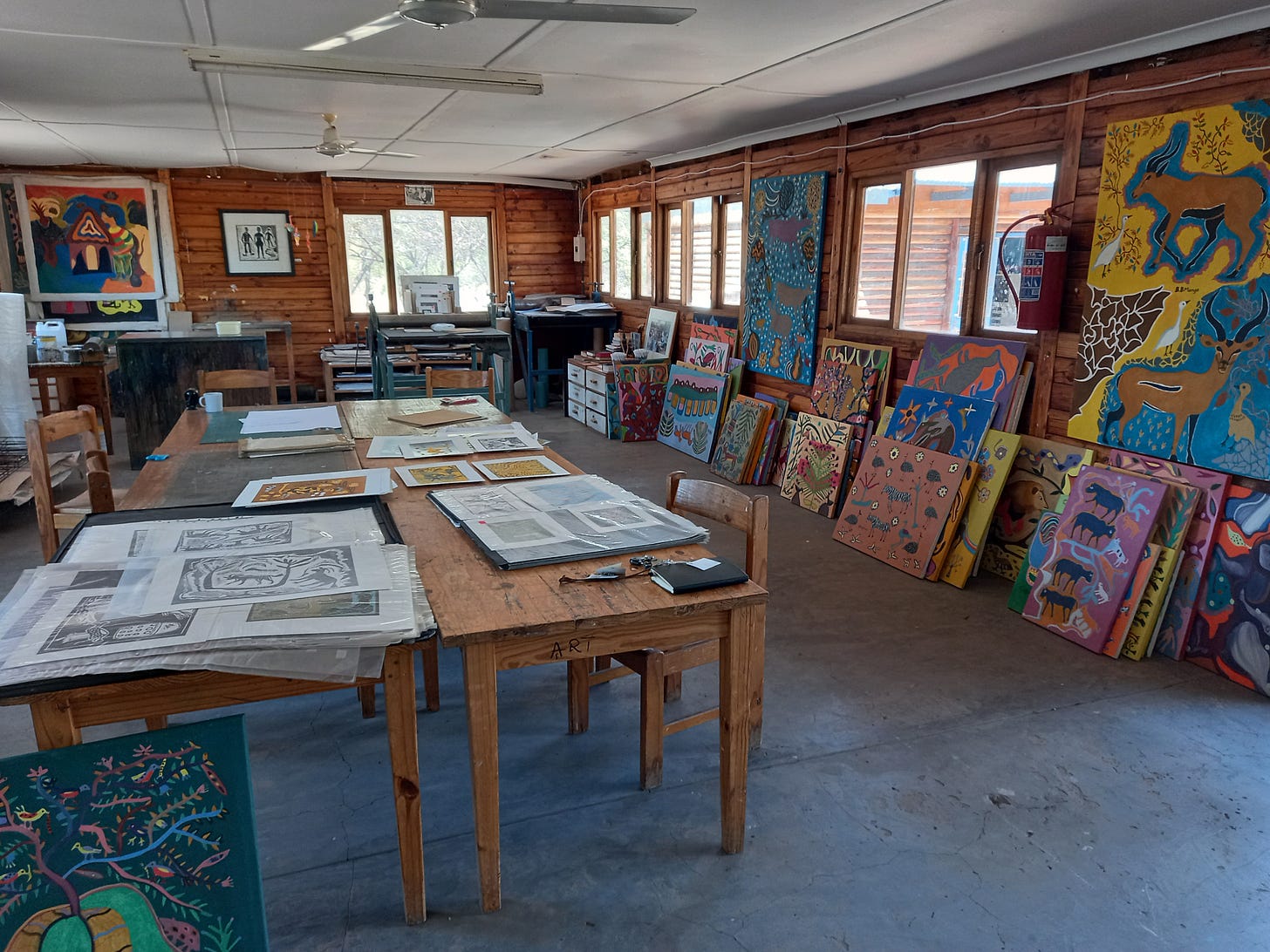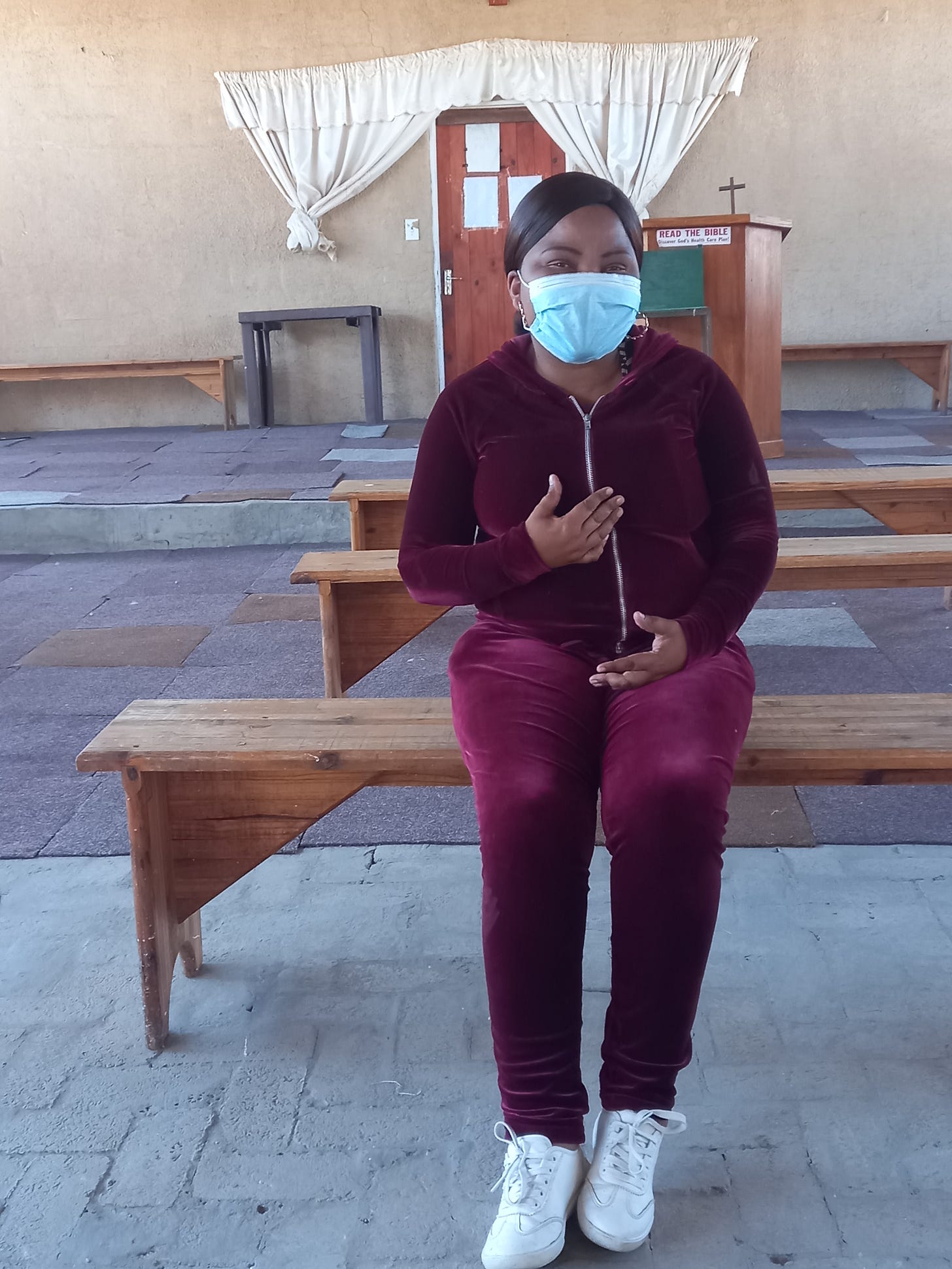Clicked: the oldest stories, the most complex languages
Hanging with the !Xoon, Naro, Xlhana [||Gana] and Qhwii [|Gwi]
6 200 words
January, 2022
PART 1: Writing Khoisan languages just as they went extinct
Two thousand years ago, before herders, agriculturalists and mercantilists began arriving in Southern Africa, only San Bushman languages were spoken. One language, /Xam dominated much of the area which under British rule became the Cape Colony. By the end of the 1800s, though, it was no longer spoken.
In the 1870s linguists Wilhelm Bleek and his sister-in-law, Lucy Lloyd, had former prisoners, /Xam speakers, move into their household in Mowbray, Cape Town, over more than a decade recording their language and mythologies.
But just in a matter of a few decades, when Bleek’s daughter, Dorothea, who as a child heard /Xam being spoken in the household, visited the deep Karoo where the /Xam storytellers had lived, she could not find /Xam speakers nor anyone who recalled the stories which had delighted her father and aunt.
Dorothea made wagon trips to the driest and harshest parts of South Africa, as well as Botswana, Namibia, Angola and Tanzania, to record Khoisan languages just as they appeared to be dying out.
Biographer Jill Weintroub notes in Dorothea Bleek, A life of scholarship 2015, that Bleek spent decades compiling her monumental 800-page Bushman Dictionary. Published in 1956 eight years after her death, it included 28 languages and dialects. https://archive.org/details/bushmandictionar00blee
One of Bleek’s trips, in 1913, was to Kakia in Bechuanaland (now Botswana). She had heard of a San Bushman band living in conditions of serfdom to their pastoral masters. The trip meant a train ride to Lobatse, south of Gaborone, then by wagon over several arduous weeks into the semi-desert of the Kalahari. This was no jaunt. Water was in such short supply at one point that the oxen got “wild with thirst. We thought they would die.”
In Kakia she took black-and-white photographs of the Basarwa, a Setswana word for people without cattle, which are as disturbing as they are harrowing, showing raggedy people, some with distended bellies, out of place and time.
An iconic photo, taken by guide and interpreter Ompilletsi, shows Bleek with a friend, Margarethe Vollmer and three unidentified men who managed the team of 16 oxen which drew the wagon. I wondered where they were going? Where is Kakia, do Basarwa still live there and have they retained their language?
Khakhea as it is now called, shows up on Google Earth, but is not big enough to have its own fuel station. Really good tarred roads across the soft sands of the Kalahari get you there in a couple of hours. At nightfall I pulled off the road, knowing there was no formal accommodation in Khakhea, and found a quiet place to erect my tent. Bleek’s trip was in mid-winter, she describing the bracing cold of the mornings. I felt it too.
One of her photos is of the large dry pan at Kakia, a small herd of cattle standing idly by. Over a century later I took more or less the identical photo.
I drove around a cold Khakhea. There were a few shops, schools and a clinic, but hardly anyone was around. I had a copy of Jill Weintroub’s By small wagon with a full tent, 2011, with me which I showed to a shopkeeper, explaining Bleek’s 1913 journey.
The Basarwa now live at Kotuku, she said. I had passed a sign pointing to Kotuku a little earlier. About 20 kilometres away, it is smaller than Khakhea and was not on my map, nor on Google.
Fences demark each property, many with a stick enclosure to break the wind for outdoor cooking. The only activity was at a water pump. People queued, mostly with donkey carts but also the occasional 4x4 with trailer, as well as on foot, carrying a bucket. A tiny goat kid, probably just a few days old, took a keen interest in proceedings.
Goitseone Gadifele, a senior manager 140 kilometres away at Jwaneng, the world’s richest diamond mine, is a part-time farmer. He makes weekly visits to the borehole, the strongest water source in the area. We chatted while he waited for his turn at the pump. I asked if Basarwa still lived in the area.
Here comes a Basarwa man now, he said, looking behind us. A man approached, carrying a bucket. He wore a mask with an air vent, but with the mechanism missing. And here was immediately a surprise, one of many to come on the trip. Jan and I could hold an elementary conversation in Afrikaans.
“Waar het jy Afrikaans geleer?”
“Van die boere.”
But we both had limited capability in this lingua franca and being masked did not help.
Gadifele told me he had a worker on his farm who spoke SheKgalaghari, which has its base in Sesotho-Setswana and is in widespread use in the Kalahari. The worker was married to a Basarwa woman and they communicated in SheKgalaghari.
A woman approached. She said she was Basarwa and spelled her name for me which I wrote down. She scrutinised what I had written and made several corrections until what I had was correct: Kemoetshwaretse (I have forgiven you). Language distance between us, though, prevented any real conversation.
The Basarwa preferred to live in the bush and hunt, Gadifele said, but the government wanted them to stay in villages, and built houses for them, pointing to one of the formal houses just behind us. He said that 80 percent of the inhabitants of Kokotsha, about 60 kilometres south of Khakhea, were Basarwa.
Kokotsha was much like Khakhea and Kotuku. Small groups congregated at some houses, waving as I drove past. I chatted to three men, again mostly in Afrikaans, saying I was keen to meet Basarwa speakers. Two of them pointed to the third, saying he was Basarwa, but he and I had no common way of conversing.
Dorothea Bleek noted that the Basarwa at Khakhea were unable to identify the language they spoke. She suggested this resulted from a life of servitude to their pastoral masters. I too could not get an answer to this question. Some said Sesarwa [the language the Basarwa speak], others Boesman-taal.
But it was clear that more than a century after Bleek’s visit that many people in the Khakhea area identify as Basarwa and that a click language is still very much spoken. I mailed University of Botswana linguist Andy Chebanne, a specialist in Khoisan languages after my trip to ask if he knew which language is spoken in the Khakhea area?
“Southern !Xoon,” he responded. “Sometimes speakers are confused and say it is #Hoan, but it is !Xoon.”
There are no real firm numbers for how many speakers there are of Khoisan languages in Botswana. Chebanne in a 2016 paper cites the 2010 census which found that 96% of the two million population spoke 11 Bantu languages while Khoisan speakers, 3% of the total, spoke 13 different languages within three language families, Khoe, K’xa and Tuu.
By way of comparison, there are three other language families indigenous to the African continent, Afroasiastic, Nilo-Saharan and Niger-Congo. The three Khoisan language families take the overall number to six.
Chebanne speaks in a 2010 paper, of the diversity - and fragility - of these ancient languages still spoken in Botswana: “Most of these communities are small and therefore prone to undergoing language shift, dearth and even death. It is therefore vitally important that these languages should not be left to die before they have even been documented.”
And less there should be any doubt of the importance of language in cultural identity, Chebanne says this trumps all: “Performances, dances here and singing there will not guarantee language maintenance in Botswana. The use of one’s language is the greatest vehicle to reach one’s soul and for the creation of one’s vision of things in existence.”
Trans-Kalahari
I headed north from Khakhea to join the Trans-Kalahari Highway, which connects Maputo via Johannesburg to Walvis Bay. I had driven the highway 20 years ago when it was just a few years old. Outside Ghanzi, not far from the Namibian border, we stayed at Thakadu Bush Camp, where proprietor Chris Woolcott arranged a tour with San Bushmen.
We were just out of the camp when they started pulling up roots, breaking off twigs and leaves. Everything seemed to have a use. A white farmer, fluent in the language, translated. The stories, where people and animals are often deliberately mixed up, were enchanting. They answered lots of questions, including on a possible after-life (they said there is no such thing).
We were told a few times they were not afraid of lions which “were their dogs”. Their trick was to watch a den with cubs. With Ma and Pa away hunting, they’d take the cubs out and give them a damn good hiding, ensuring a lifetime of respect when they themselves were old enough to hunt.
But most remarkable of all was that the band had a woman with them who had married into it. She spoke her own click language, not a single word of which was comprehensible to the rest of the group.
We stopped at Lone Tree/Kacgae on our return, a villager telling me of a regular visitor, Wits linguist Tony Traill and describing him as “fat like me”, even though I was a Comrades runner then and to my mind at least, did not have an ounce of fat on me.
Back in Johannesburg I met Traill, who visited Kacgae annually over a 30-year-period to learn to speak and write !Xoon, eventually producing an English-!Xoon dictionary.
I was mesmerised by his stories and worldview. The new road, then unfenced, meant that cattle were often run over by giant trucks. One day, with !Xoon men, they came across a recent kill and stopped to inspect. No ownership markings were evident.
One man drew a knife and threw sand on the animal, using this to sharpen the knife. Then in a single movement he cut off a haunch and climbed on the back of the vehicle. Traill found himself driving what became the getaway vehicle. They turned off the road, one of the men using a branch to erase their tracks, and then found a grassy knoll. The haunch was placed on the knoll which was set alight to cook the contraband.
Traill confirmed that the San Bushman languages can be so different that neighbours do not understand one word of one another’s language.
Just how different are they, like English and Latin?
“Like English and Chinese.”
Now, 20 years later, I was on my way back to Lone Tree/Kacgae, this time with a copy of Traill’s !Xoon dictionary, one of humanity's most complex languages, a lonesome copy which I had found in an obscure library at Wits.
Clicked: the oldest stories, the most complex of languages
PART 2: A village with its own dictionary
A few men stood on the side of the road at the turn-off on the Trans-Kalahari Highway to Lone Tree/Kacgae, a 900-person village deep in the sparsely-populated country of Botswana. Pulling over, two men approached, one slight, wearing a Kaizer Chiefs t-shirt and thick, trendy glasses.
I could buy a powdery substance or a two-litre bottle of red liquid that he and a friend were offering, but I was much more interested in the fact that we were speaking English.
“Can you speak !Xoon?” I asked.
Yes, he said, we immediately agreeing he would accompany me to Kacgae, 11 kilometres off the main road.
In the car, Dithabololo Magosane (“Call me Dee”) told me that he was a hustler.
I asked how come he could speak !Xoon?
“My mother is Mosarwa [Mosarwa is singular for Basarwa, Setswana for people without cattle].”
His phone rang. “Hisit my bru,” he said, beginning an animated conversation.
When he ended I asked: “You speak Afrikaans?”
“No, bru is brother in Kgalagadi [as it is in Afrikaans].
I wanted to meet someone who could read !Xoon, I told him.
“No problem,” he said, a phrase he uses often.
We turned off the dirt road as we entered the village, following a set of sandy tracks between fenced-off properties, some with mud and others, brick houses. We parked near Dee’s home, and walked a short distance to meet his cousin. I had expected that this would be someone with seniority, but his cousin was a relatively young adult. I offered her a pen and notebook to write her name. She responded: “Have you got hand sanitiser in the car?”
Moroba Qhamoke, who had her hair and much of her face covered with a scarf, was wearing blue pyjamas emblazoned with Disney characters. She pulled up a bucket for herself and offered me a chair, her infant son pulling up his own small chair too.
“Where’s the dictionary?” Qhamoke asked, opening it and started reading, flanked by Dee’s partner, Gaone Peke, who read along with her. A small group gathered, all masked up for Covid, including Qhamoke’s wizened grandfather, Koloti Jumase, who squatted to one side.
The pair read out word by word, click by click and then translated the phrase into English, the others sharing in the delight of having transformed text into intelligible sounds.
“I don’t want to fight.” Then: “They want them to hunt.” And: “What do you want?”
Having read some of the phrases, Qhamoke would look at me: “Yes, it’s correct.”
I asked what her grandfather thought? She read to him and then translated what he said: “It is correct and written perfectly.”
Could her grandfather tell us a hunting story from the old days? Qhamoke obliged by writing his spoken !Xoon into English. It wasn’t much of a story. He and others had got some dogs and gone to hunt, but came across a tiger [leopard] and so returned.
But I thought the Basarwa weren’t afraid, even of lions?
Qhamoke looked at me: “It depends whether they’ve eaten or not.”
She said she had been educated at schools in the region and was 30. I asked her what work she did. She looked at me for a moment: “There is no work”.
Traill, who died in 2007, thanks several !Xoon speakers in his dictionary which was printed in 1994: “I owe my greatest debt to all the !Xoo who have patiently taught me their language and instructed me in many aspects of their culture. They will never really know how compellingly fascinating this education has been for me.”
He in particular thanked Bolo //xao: “He has been a brilliant teacher with a wonderful sense of humour and an uncanny understanding of the limits of the western mind.”
Bolo //xao died a few years after Traill, but we went to meet his wife Beaty Bushe, who Traill also thanked. Cynthia Xhari, one of Dee’s many sisters (I read later that most villagers see themselves connected through kinship), read from the dictionary in English, Beaty and her sister Xhomane Xwaase, joining in with Xhari as she read the !Xoon translation of the English.
!Xoon is cited as humanity’s most complex language. In 2009 The Economist went in search of the world’s most difficult-to-speak languages: “For sound complexity, one language stands out. !Xóõ, spoken by just a few thousand, mostly in Botswana, has a blistering array of unusual sounds. Its vowels include plain, pharyngealised, strident and breathy, and they carry four tones.
“It has five basic clicks and 17 accompanying ones. The leading expert on the !Xóõ, Tony Traill, developed a lump on his larynx from learning to make their sounds. Further research showed that adult !Xóõ-speakers had the same lump (children had not developed it yet).”
A facebook page under the name of the Khoi Liberation Front, features a story which it says was shared with Traill by his teacher Bolo //xao. Trail reads the story, the audio being accompanied with text in !Xoon and English: https://m.facebook.com/groups/khoiliberationmovement/permalink/2453122408071956/
A track cut through the Kgalagadi
The 10 000-square kilometres the !Xoon inhabited could seem to outsiders as a featureless thornveld, Traill wrote in The Kalahari Khoisan (2004). “A standard map presents the area as largely empty. There is no hint that this empty space was created by Bihi sa bolo who, together with the ancestors of the !Xoo, named every part of it.”
Bihi sa bolo made the communities of vegetation, the pans, waterholes and their drainage lines, the people and animals. “People added their village sites, hunting camps, initiation sites and each, finally, their faces, that is, their graves.”
This was all to change, though, from the 1950s when a track was cut from the Kgalagadi village of Kang to Ghanzi through the centre of !Xoon country. “!Xoon living in the vicinity of the route were recruited to clear the bush and worked enthusiastically for the rations they were given,” Traill wrote.
Boreholes were sunk to provide watering points to trek cattle across the Kalahari. !aja became Lone Tree; //auba (Small Camelthorns) became Digby’s Wells and later Lokalane.
“As the water flowed the !Xoo emerged from the ancient landscape to the east and west created by Bihi sa bolo, to drink and squat around this amazing bounty.”
The track which the !Xoon helped cut is visible on Google Earth and runs close to the highway. I drove some of it and, with Dee Magosane, visited what had been the !aja water hole before being renamed Lone Tree. It is close to the junction where the dirt road to the village meets the highway. This well has not been in use for some time. It is concreted over, a large trough standing empty alongside. The water needs of the village are now supplied nearby from a borehole with a giant shiny tank.
Qhamoke’s grandmother, Cwiigi Pege, remembered the dirt road being put in when she was growing up. She had lived near the new borehole. Later, when the government developed the village on the present site with a school, clinic and a new borehole, she moved there.
Mutually unintelligible languages, common mythologies
Isolated living in the Kalahari, Traill wrote, with time depths of “thousands and thousands and thousands of years” meant the Khoisan evolved practical systems to exploit its resources through foraging and hunting while filling the Kalahari “with rich symbolic and spiritual systems to explain it all.
“This was imagination and ingenuity shaped by tradition, myth and metaphor, combined with a deep pre-scientific knowledge of the environment, in which hypothesising and prediction are also used to understand climate, geology, vegetation, insects, birds mammals and water - or rather, its shortage.”
Even though neighbouring languages were mutually unintelligible, Kalahari Khoisan speakers shared common mythologies suggesting “a single, underlying and ancient source rendered opaque linguistically by the passage of time”.
Genetic analysis now allows us to peer deep into humanity’s past, the Khoisan having the most ancient of human lineages and the greatest genetic diversity. Brigitte Pakendorf and Mark Stoneking, in The genomic prehistory of peoples speaking Khoisan languages, 2020, say recent analysis of the most complete geographical coverage of Khoisan-speaking groups have shown a tripartite split into northern, central and southern Khoisan-speaking groups.
The variances for when the split took place is extremely wide on the available data, anything from 25 000 years to 160 000 years ago, but this genetic split does not show up linguistically. The northern group includes speakers from both the K’xa and Khoe families while the south-eastern/central group includes speakers from all three language families.
Death of a rainmaker
Traill tells of a waterhole named //goe ka where “for centuries !Xoo men filling their containers have known that below the rock, beneath the waterhole lie the buried remains of the !Xoo Aphrodite, killed by the exasperated married men she persistently tried to seduce”.
Neglect had meant that another hole, /nule //goe ka, had an accumulated deposit of soil and had lost its capacity to hold water for long periods. “Nevertheless it is into waterholes like this that /luma, the python, the quintessential water creature, can still be seen returning to earth each rainy season from its home in the immense black rain clouds.”
These may well be the oldest stories ever told, or at least those which the re-telling has kept alive for the longest time. In my conversations with click language speakers, I asked if they knew stories from the past, hoping to hear of the escapades of the water snake. But while I did hear of pythons, these were of the real, not watery kind, big enough to swallow an antelope whole.
Earlier this year, though, /luma no doubt visited the Thakadu Bush Camp outside Ghanzi, where I pitched my tent and which I used as a base for three days. The bar and restaurant area overlooks a pan, usually dry. So much rain fell in April that enough water flowed out of the pan to create a mini lake, flooding the building. The camp, which had been in lockdown because of Covid, was delayed opening for another two months waiting for the deluge to subside.
I had been told by a few people on my trip how to make rain, the key being to collect special plants which give off condensation when put on a fire. My guess, though, was that this was an abridged version, because Traill, in The Kalahari Khoisan, provides detail on the numerous taboos and rituals which have to be met.
“Creating favourable conditions for rain is an intricate matter. There are taboos to be observed such as never digging up the ritually powerful root of llgaa, Hermannia stricta, during ‘llnahu, the rainy season, and rituals to be followed such as urinating on a fire during llgaa, the hot dry season to cool the fierce heat of the sun, or, if your birth omens are right, ritually burning an appropriate skin whose smoke rises eventually to oho, condense and form rain.
“The long purring call of the qa’bi, the rufous cheeked nightjar, another creature of the rain, tells people not to extinguish their fires before sufficient smoke has risen to the sky. The rain is also to be protected from mischievous powers by avoiding its conventional name !qhaa; instead it must be referred to as na’m.”
Traill said that powerful shamans are associated with rain, nowhere better demonstrated than at the moment of death of Tuhuse in the middle of the !ae, the cold dry season of 1996. “He was the patriarch of liq’ua waterholes, a healer, the senior administrator of male initiation and, as benefitting a man of his powers, when breath left his body one black night in August, 1996, it was with explosive thunder and drops of rain fell. He revered the rain in his death.”
We scoff at the ancient wisdom of rainmakers now, even though their explanations reigned for “thousands and thousands and thousands” of years. The present scientific-industrial paradigm, dominant for the past few hundred years, has given us all the knowledge in the world, but apparently not the wisdom to know that destroying the planet we inhabit is unimagingly dumb.
PART 3: Word tools for a modern world
An hour along the Trans-Kalahari highway from Kacgae is Ghanzi, a frontier and desert town, 300 kilometres from Gobabis, the closest Namibian town. Naro is the dominant Khoisan language spoken here. I wondered, over breakfast at the Red Kitchen on a main street, how I could meet a Naro speaker?
The waitress, Caroline Karambuka, said they were out of coffee and kept me informed as the proprietor went in search of supplies. I asked the 26-year-old which languages she speaks. Naro was one of them. And, not only can she speak Naro, she writes it too. At my request she wrote a selection of words, including her Naro name, Ntcisa.
Forty kilometres up the road at D’Kar is the Kuru Art Project (kuruart.com) which sells paintings and lithographs by San artists in a project initiated by the Reformed Church in Botswana, with the assistance of the Mission of the Christian Reformed Churches in the Netherlands. The Naro Language Project, which is busy translating the Bible into Naro, is also based at D’Kar.
Convenor Isaac Saul told me the translation of the New Testament was complete and that they were working on the Old Testament. Saul speaks Naro, G//ana, G/ui and “a bit of Shekgalagari, Ju’|choansi, Setswana and Kiswahili”. This is an impressive list, but not all out of the ordinary. Most people I met spoke at least three languages; five was not unusual.
I told Saul that I was surprised at how easy it was to meet Khoisan speakers and that I sensed a linguistic vibrancy. He said the Botswana government had until now only allowed the teaching of English and Setswana at schools. But under president Mokgweetsi Masisi from next year 13 of the country’s 26 languages will be taught, Naro being one of them.
This is possible because materials such as the Naro-English dictionary have been in development since the 1990s, the work of Hessel and Coby Visser of the Texas-headquartered Summer Institute of Linguistics (SIL). Its mission is to develop languages not yet in written form, by producing orthographies and grammars; teaching people to read and write; and to translate the Bible into languages not yet in written form. A dictionary is compiled as a first step to producing a Bible.
The Vissers now live just outside Ghanzi. We sat in the garden, frequent flights taking off from the adjacent airport, appearing to somewhat unnerve Visser. The airport is normally inactive: now it was busy, apparently ferrying Covid patients to hospitals in the major centres.
Armed with a rudimentary course in linguistics, Visser arrived in Ghanzi 30 years ago and met his first Naro speakers. So began the painstaking process of producing a dictionary, the first version which took five years. Three further editions have followed, the latest reprint being in 2016.
As difficult as it might be to learn a Khoisan language and to implement a system to write it, Visser said that translating the Bible into Naro was more difficult, a simple example being there are 18 different words for ‘we’ in Naro.
New Xade
One hundred and ten kilometres from Ghanzi, on a bone-jarring road, is New Xade, which I had also visited 20 years back. It is like other Kalahari villages, although somewhat drier and harsher. Residents put the number of people living there at between 1 500 and 2 000.
In 1997 and again in 2002 the government controversially relocated Xlhana and Qhwii speakers from Xade in the nearby vast Central Kalahari Game Reserve (CKGR) to New Xade. I stopped at a store, meeting storekeeper Tikologo Gabelekgolelwe who previously lived in Xade. Did she ever visit there? “Yes, my parents still live there.”
Hessel Visser’s wife, Coby, who has been active in the Naro language project, gave me the contacts of a member of their church, Cgoa Boitumelo. We walked a few blocks from her house to a modest church, passing a small throng waiting for a monthly allocation of foodstuffs. Is this only for New Xade people, I asked? Boitumelo said all indigent people are eligible.
Seated in the church, Boitumelo, in a mauve track suit and white sneakers, said she was 35 and Mosarwa. Her father is a Naro speaker and her mother, Xlhana. She speaks Xlhana, Naro, Setswana and English, not counting Qhwii, which I was to find she at least understands. Hessel Visser had told me that Xlhana and Qhwii are relatively similar, say like Dutch and Afrikaans.
We chatted on a range of topics: food foraging being part of everyday way of life while hunting is illegal. Boitumelo owns 40 goats which roam the area. Cultural practices such as initiation rituals are part of the fabric of life in New Xade, one being held by older women the previous weekend. Only women? Yes, she said, men are not allowed.
I asked Boitumelo about life in the Central Kalahari Game Reserve. She related a story told by her grandmother who with her grandfather had fallen asleep one night, forgetting to close the door of their hut. A lion entered. The grandfather said to the grandmother: “Something is biting me. It’s a lion.” He told her to take the baby and go outside quickly. She did as instructed.
“My grandfather was left inside with the lion. The lion was still biting him on the leg. He kicked the lion which let him go and he ran outside the hut too to call for help. The lion meanwhile escaped from the house and ran away.”
Was your grandfather okay?
“He was not okay, but he survived, with wounds in his leg. He was showing us the wounds.”
I told Boitumelo I was keen to meet a Qhwii speaker. She pondered a bit, pulled out her cell phone and called her uncle, Kedago Podi, who lives a few houses away and soon arrived. Podi (which means goat, Boitumelo said) was wearing a two-toned baseball jacket, denim longs, sandals, and, of course, a mask.
And so began an extraordinary conversation, for me, in English-Xlhana-Qhwii. When hunting was still legal, how long would a hunt last? The answer: up to five or six days.
Which animals had he successfully hunted? Podi gave examples of a leopard, giraffe and impala, in cases having to fight off lions “which wanted to take my animal” after he had killed it.
How did he do that? How did he keep the lion away from the dead giraffe?
“It was my meat so I was chasing it so I can have my meat.”
But surely he was not alone? He had other men with him?
“There were two, just two.”
But there can be ten lions? How do you chase them?
“It’s simple. We just chase them.”
A house without snakes
Click language speakers in Botswana sometimes hide this fact. Herman Batibo, professor of linguistics at the University of Botswana, says in a blog post “often when I ask my students: Who speaks a Khoisan language?, no one raises their hand. Later, students will come to my office to tell me that they do speak a Khoisan language but didn’t want to say so in front of their classmates.” Hessel Visser told me that this was “also very common in school situations”.
But it was not my experience. After introducing myself I would ask if the person was a Motswana (singular for Botswanan). In the Kalahari the answer was usually Kgalaghadi (or Ba-Kgalagadi), Basarwa (or Mosarwa) being the next most likely answer.
Ketelelo Moapare is a New Xade resident who embraces his San identity. Moapare, an orphan brought up by his grandparents, completed his schooling at Ghanzi before attending college in Gaborone and winning a scholarship to study engineering at Michigan State University in the United States.
He features in a 2016 documentary A house without snakes, with another young man, Kitsiso Gakelekgolelwe, as they ponder village life and their futures. The title comes from the houses, some of which have walls of tree branches rather than brick or mud, meaning snakes can slither through.
Moapare says he sees a lot of hopeless faces in New Xade. “People here are undergoing a lot of change and we are losing our way of life.” He meets an elderly woman resident and asks how she is? “I’m not here,” she replies. “It’s just my shadow.”
Writing in the Kalahari Review in 2016 Moapare tackled a BBC report which he said portrayed “New Xade as disease-ridden and impoverished, with residents struggling to adapt to modern life.” He took exception to a photo used in the article which depicted San men wearing clothes made from animal skins. “This is another attempt by the BBC to show that the San long for a ‘primitive life’, evoking the fallacy of the ‘noble savage’.
Rather, he said, ”the residents of New Xade, including myself, have embraced modern developments, and have used these opportunities to pursue a better life . . . the San have moved from relying on hunting and gathering to more modern forms of livelihoods. My own family has fully embraced this, and my grandfather keeps goats, sheep, cattle, and sells them to make money.”
Moapare said that while studying in Gaborone his schoolmates constantly asked him about the San after he told them he was a “Bushman”. Did he know how to hunt and gather, they asked, laughing when he answered “no”.
“Most residents and village leaders of New Xade recognise the positive gains from the relocation program,” Moapare wrote. “The San face challenges brought by modern life, but are committed to overcoming them. All societies have transitioned from primitive life to modernity and the San are on the same trajectory of transition. We are farmers, business owners, teachers, professionals, and Michigan State University students.”
I had been unable to contact Moapare via the Internet, but chatting on Whatsapp with Cgoa Boitemelo, she said she knew him and that he was back in the village. She gave me his phone number and I called him from Johannesburg.
Having completed a four-year economic geography degree and a professional certification in geographic information systems (GIS) at Michigan State, Moapare is planning to return to the United States to complete a Masters in urban and environmental planning at a university in Texas, and is in the process of securing scholarship funding.
Which of the Khoisan languages does he speak?
“Xlhana, Qhwii and about 90% or 95% of Naro.”
Away with the sticks
I met perhaps half a dozen people in New Xade. Half of them spoke of a Japanese linguist who visits regularly. Hirosi Nakagawa, a student of Tony Traill’s who completed his PhD in linguistics at Wits in 2007 is now at the Tokyo University of Foreign Studies. Nakagawa, a specialist in Qhwii, has, in collaboration with anthropologists Kazuyoshi Sugawara and Jiro Tanaka, a 3 000-word English-Qhwii dictionary in progress which he aims to publish next year.
Nakagawa, who told me by email that he speaks Qhwii and “passively understands” Xlhana, has been working on Qhwii for 29 years. “I visited the Xade village, Central Kalahari Game Reserve in August, 1992 for my first field work.”
He helped complete The Trilingual !Xoo Dictionary, 2018, in !Xoo, English and Setswana, a project unfinished by Traill when he died. Nakagawa worked on the !Xoo-English section, University of Botswana linguist Andy Chebanne on Setswana-!Xoo.
In Ghanzi Hessel Visser told me he had decided to use the 26-letter Roman alphabet for his Naro dictionary rather than the symbols - the slashes, dashes and what-have-yous - usually used to reflect the various click sounds. His reasoning is simple. He imagines a click speaker in a queue at, say, a post office. When he gets to the counter he is asked for his name and then to spell it. Neither he nor the post office worker are likely to be able to do this.
For Visser too, the more user-friendly the alphabet is, the easier it will be to read his Naro Bible.
I had bought a copy of his Naro dictionary at D’Kar. It uses both the Roman alphabet and the diacritic system of the International Phonetic Association (IPA). The former is much easier to read. Indeed, I find it readable, even though I’d have to confer with Naro speakers to get the pronunciation right. I haven’t found this in any other dictionary of a click language.
Visser speaks of a workshop in D’Kar 20 years back where the issue of orthography was discussed. Naro speakers were present as academics agreed in favour of keeping the current complex writing system. The Naro speakers’ view, though, was simple: “Away with the sticks!”
I asked if he thought the 26-letter alphabet could be used for !Xoon? He replied he did not think this a “fruitful avenue''. “It is not impossible, but squeezing all those phonemes into a system of 26 letters will be quite an endeavour.” A glance at Tony Traill’s dictionary confirms this: !Xoon has 136 different sounds.
Chebanne says a practical orthography or writing system for !Xoon remains an issue, a point acknowledged by Traill who saw the need for a simpler, more accessible system than his. The IXoon do not believe they have a usable orthography for their language, Chebanne said, adding community initiatives are required to demonstrate whether their writing system should use the International Phonetic Orthography or the Naro-type system, the latter being closer to the South African Nguni orthography.
He puts the number of people who identify as !Xoon at about 2 000, of whom 800 are fluent speakers. But alas, even with the numbers this low, there is no initiative underway to develop a user-friendly orthography. This is necessary, says Chebanne, if !Xoon is to benefit from the new government policy on mother tongue education.
First published by New Frame, January, 2022

